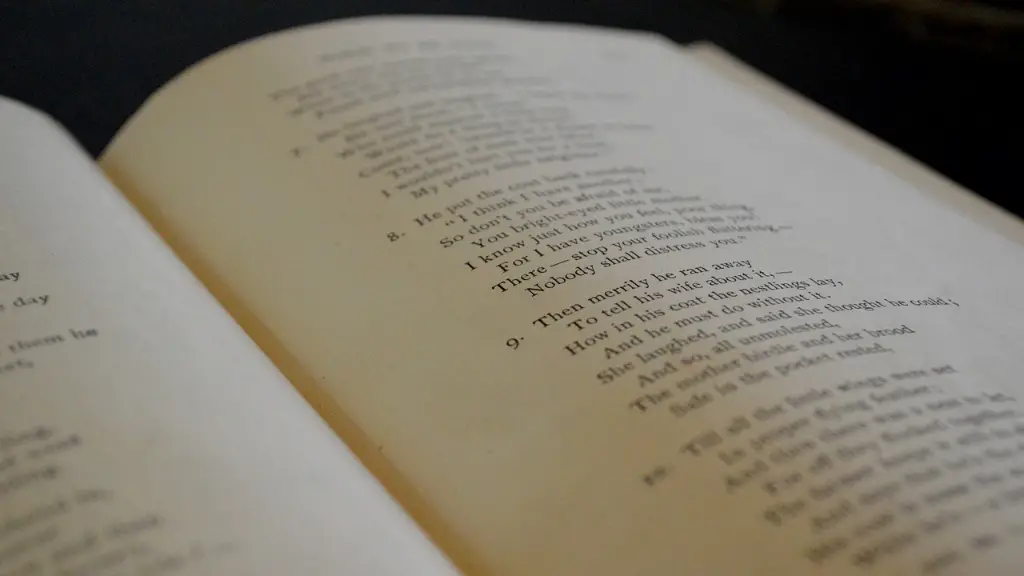Poetry books often come in a wide range of shapes, sizes, and lengths, but it can be difficult to determine just how many pages a given volume should have. Most books of poetry are composed of individual works, rather than one long piece, and as such, it is difficult to come up with a definitive answer to the question of how many pages a poetry book should be. However, there are a few general guidelines that should be taken into consideration when designing a book of poetry.
The first question to consider is what type of poetry is being included in the book. Traditional poetry collections will generally contain the work of several different poets, while a book of poetry by a single poet or an anthology of poems on a certain theme will be shorter. Additionally, the size of the font and the number of words on each page need to be taken into account. For instance, a book featuring small print and a great deal of white space will have fewer pages than one with large print and no white space.
Major publishing houses will have specific guidelines when it comes to how long a book should be. Most single-author volumes of poetry published by major publishers will usually range from 60 to 120 pages, but the exact length depends on a variety of factors, such as the length of individual poems, font selection, and the inclusion of artwork.
Self-publishing poetry collections, on the other hand, offer more freedom. A single-author collection of short verses and micro-poetry could be 20 pages, while a collection from a single author featuring longer and more complex poems could easily exceed 120 pages.
It is also important to consider the audience for whom the book is intended. Small press and independent publishers may be willing to publish books that are shorter than the traditional length of a poetry collection. Additionally, libraries may have different size requirements when it comes to stocking a particular book on their shelves. Of course, the cost of printing needs to be taken into account as well. As such, authors should carefully consider the number of pages when designing their book.
Ultimately, there is no one-size-fits-all answer to the question of how many pages a poetry book should be. What is most important is that the author takes into account the type of poetry being employed, the size of the font and layout, and the audience for whom the book is intended. By carefully considering all of these factors, authors and publishers can come up with a book of poetry that is both aesthetically pleasing and of appropriate length.
Layout and Design Considerations
The aesthetic design of a poetry book should be taken into consideration, as this will have an effect on the overall length of the book. How the pages are laid out and the spacing of the text is especially important, as it will have an effect on the overall appearance and size of the book. For instance, if the font size is increased and more white space is added, the number of pages can be reduced. Additionally, if the page layout is planned carefully, it will be easier to ensure that the book comes in an appropriate size.
Likewise, if artwork or images are added to the book, this also affects the overall length. When considering artwork, it is important to choose works that are relevant to the text and do not add too much page length. Photos, illustrations, and drawings can all be used to create an aesthetically pleasing book of poetry, but authors should be aware that this will influence the size of their book.
Cost Considerations
Finally, the cost of printing should be taken into account when determining how many pages a book of poetry should have. The cost of printing will vary depending upon the size and number of pages, so authors should determine what the print cost per page is before making a decision. Additionally, authors should be mindful of the quantity of the print run; it may be cheaper to print smaller numbers of books with fewer pages, while larger print runs will require a larger scale and a bigger budget.
In conclusion, the exact number of pages in a book of poetry will depend on a variety of factors. Before deciding how many pages a particular book should have, authors and publishers should take into consideration the type of poetry being included, the desired layout, and the cost of printing. By being mindful of these considerations, authors and publishers can create a book of poetry that is both aesthetically pleasing and of appropriate length.
Research Process
In order to write a successful book of poetry, it is important to have a thorough understanding of the poetry being included. This includes researching the individual poets, reading the poems and becoming familiar with the type of material that is being used. Research into particular topics or historical events may also be necessary, as this can influence the poems being written and the aesthetic of the entire book.
When researching a book of poetry, authors should examine the work of poets from different eras and consider the societal context. Becoming familiar with the parameters of traditional poetry styles can help authors avoid clichéd language, while researching different poetic structures and forms can lead to more creative works. Additionally, authors should consider how the particular poems can be organized in the book, what types of images and art should be used, and the best font to use.
Challenges of Writing Poetry
Creating a book of poetry is a challenging undertaking, as authors must be able to craft poems that are both aesthetically pleasing and emotionally resonant. Writing poetry is an arduous art form, and authors should take the time to carefully consider their words and their message. Additionally, poets must be able to empathize with their reader and come up with work that truly speaks to them.
When writing a book of poetry, authors should strive for clarity and concision. Complex thoughts and ideas can be more effectively conveyed with fewer words and simpler images. Additionally, authors should avoid relying too heavily on one particular style or structure, as this can quickly become monotonous. By taking the time to craft thoughtful and meaningful poems, authors will be able to create works that are both aesthetically pleasing and emotionally resonant.
The Unifying Power of Poetry
One of the most interesting aspects of poetry is its potential to unite seemingly disparate individuals and cultures. By crafting work that touches on issues of shared concern, poets can overcome traditional boundaries in a very powerful way. For example, a poem written in one language can be translated into another to create a work that can be shared and appreciated by readers from different backgrounds.
Poetry has the power to move the hearts and minds of readers, and this unifying potential should not be overlooked. By taking the time to craft thoughtful and meaningful works, authors can create books of poetry that will move readers and inspire them to think and feel more deeply.
The Role of Poetry in Society
The role of poetry in society has changed throughout the years, but it continues to be an effective means of expressing complex emotions and ideas. Over the years, poetry has been used as a tool to challenge and confront oppressive ideologies, as well as to inspire hope and bring people together. In this way, poetry has an immense power to create positive change, and authors should take this into account when writing their works.
Additionally, poetry can be a useful tool for teaching, both in the classroom and in informal settings. Poems are an effective way to convey abstract concepts, while also fostering an appreciation of literature among young people. By creating meaningful works of poetry, authors can help to shape the minds and souls of their readers and make a lasting impact.




